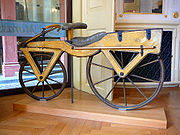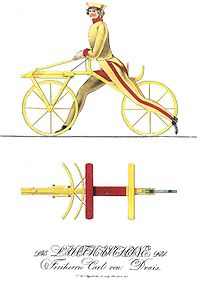
Dandy horse
Encyclopedia


Human-powered transport
Human-powered transport is the transport of person and/or goods using human muscle power. Like animal-powered transport, human-powered transport has existed since time immemorial in the form of walking, running and swimming...
that, being the first means of transport to make use of the two-wheeler principle, is regarded as the forerunner of the bicycle
Bicycle
A bicycle, also known as a bike, pushbike or cycle, is a human-powered, pedal-driven, single-track vehicle, having two wheels attached to a frame, one behind the other. A person who rides a bicycle is called a cyclist, or bicyclist....
. The dandy horse was invented by Baron Karl Drais
Karl Drais
Karl Drais was a German inventor and invented the Laufmaschine , also later called the velocipede, draisine or "draisienne" , also nicknamed the dandy horse. This incorporated the two-wheeler principle that is basic to the bicycle and motorcycle and was the beginning of mechanized personal...
in Mannheim
Mannheim
Mannheim is a city in southwestern Germany. With about 315,000 inhabitants, Mannheim is the second-largest city in the Bundesland of Baden-Württemberg, following the capital city of Stuttgart....
, Germany
Germany
Germany , officially the Federal Republic of Germany , is a federal parliamentary republic in Europe. The country consists of 16 states while the capital and largest city is Berlin. Germany covers an area of 357,021 km2 and has a largely temperate seasonal climate...
, and patent
Patent
A patent is a form of intellectual property. It consists of a set of exclusive rights granted by a sovereign state to an inventor or their assignee for a limited period of time in exchange for the public disclosure of an invention....
ed in January 1818. It is also known as a Laufmaschine (Drais' own terminology, German
German language
German is a West Germanic language, related to and classified alongside English and Dutch. With an estimated 90 – 98 million native speakers, German is one of the world's major languages and is the most widely-spoken first language in the European Union....
for "running machine"), velocipede
Velocipede
Velocipede is an umbrella term for any human-powered land vehicle with one or more wheels. The most common type of velocipede today is the bicycle....
, or draisine
Draisine
A draisine primarily refers to a light auxiliary rail vehicle, driven by service personnel, equipped to transport crew and material necessary for the maintenance of railway infrastructure....
(a term now used primarily for light auxiliary railcars regardless of their form of propulsion), and in its French form draisienne.
The dandy-horse was a two-wheel
Wheel
A wheel is a device that allows heavy objects to be moved easily through rotating on an axle through its center, facilitating movement or transportation while supporting a load, or performing labor in machines. Common examples found in transport applications. A wheel, together with an axle,...
ed vehicle, with both wheels in-line, propelled by the rider pushing along the ground with the feet as in regular walking or running. The front wheel and handlebar assembly was pivoted to allow steering.
Several manufacturers in France
France
The French Republic , The French Republic , The French Republic , (commonly known as France , is a unitary semi-presidential republic in Western Europe with several overseas territories and islands located on other continents and in the Indian, Pacific, and Atlantic oceans. Metropolitan France...
and England
England
England is a country that is part of the United Kingdom. It shares land borders with Scotland to the north and Wales to the west; the Irish Sea is to the north west, the Celtic Sea to the south west, with the North Sea to the east and the English Channel to the south separating it from continental...
made their own dandy-horses during its brief popularity in the summer of 1819—most notably Denis Johnson of London, who used an elegantly curved wooden frame which allowed the use of larger wheels. Riders preferred to operate their vehicles on the smooth pavements instead of the rough roads, but their interactions with pedestrians
Pedestrian
A pedestrian is a person traveling on foot, whether walking or running. In some communities, those traveling using roller skates or skateboards are also considered to be pedestrians. In modern times, the term mostly refers to someone walking on a road or footpath, but this was not the case...
caused many municipalities
Municipality
A municipality is essentially an urban administrative division having corporate status and usually powers of self-government. It can also be used to mean the governing body of a municipality. A municipality is a general-purpose administrative subdivision, as opposed to a special-purpose district...
to enact laws prohibiting their use. An apparent further drawback of this device was that it had to be made to measure, manufactured to conform with the height and the stride of its rider. No manufacturer appears to have taken up Nicéphore Niépce
Nicéphore Niépce
Nicéphore Niépce March 7, 1765 – July 5, 1833) was a French inventor, most noted as one of the inventors of photography and a pioneer in the field.He is most noted for producing the world's first known photograph in 1825...
's 1818 invention of an adjustable saddle for his 'velocipede'. After its brief moment in the limelight
Limelight
Limelight is a type of stage lighting once used in theatres and music halls. An intense illumination is created when an oxyhydrogen flame is directed at a cylinder of quicklime , which can be heated to 2572 °C before melting. The light is produced by a combination of incandescence and...
, the dandy-horse quickly faded into oblivion.
However, in the 1860s in France
France
The French Republic , The French Republic , The French Republic , (commonly known as France , is a unitary semi-presidential republic in Western Europe with several overseas territories and islands located on other continents and in the Indian, Pacific, and Atlantic oceans. Metropolitan France...
, the vélocipède
Velocipede
Velocipede is an umbrella term for any human-powered land vehicle with one or more wheels. The most common type of velocipede today is the bicycle....
bicycle
Bicycle
A bicycle, also known as a bike, pushbike or cycle, is a human-powered, pedal-driven, single-track vehicle, having two wheels attached to a frame, one behind the other. A person who rides a bicycle is called a cyclist, or bicyclist....
was created by attaching rotary cranks
Crank (mechanism)
A crank is an arm attached at right angles to a rotating shaft by which reciprocating motion is imparted to or received from the shaft. It is used to change circular into reciprocating motion, or reciprocating into circular motion. The arm may be a bent portion of the shaft, or a separate arm...
and pedals
Bicycle pedal
A bicycle pedal is the part of a bicycle that the rider pushes with their foot to propel the bicycle. It provides the connection between the cyclist's foot or shoe and the crank allowing the leg to turn the bottom bracket spindle and propel the bicycle's wheels...
to the front-wheel hub of a dandy-horse.
In popular culture
Buster KeatonBuster Keaton
Joseph Frank "Buster" Keaton was an American comic actor, filmmaker, producer and writer. He was best known for his silent films, in which his trademark was physical comedy with a consistently stoic, deadpan expression, earning him the nickname "The Great Stone Face".Keaton was recognized as the...
rides a dandy-horse in his 1923 film Our Hospitality
Our Hospitality
Our Hospitality is a silent comedy directed, produced, written by and starring Buster Keaton. Released in 1923 by Metro Pictures Corporation, the movie uses slapstick and situational comedy to tell the story of Willie McKay, a city slicker who gets caught in the middle of the infamous Canfield &...
, which is set in the 1830s. Keaton's technical crew were unable to obtain an actual dandy horse, so they built one to match existing drawings and prints. Keaton later donated the machine to the Smithsonian Institution
Smithsonian Institution
The Smithsonian Institution is an educational and research institute and associated museum complex, administered and funded by the government of the United States and by funds from its endowment, contributions, and profits from its retail operations, concessions, licensing activities, and magazines...
, which had lacked an authentic example.
George Arliss
George Arliss
George Arliss was an English actor, author and filmmaker who found success in the United States. He was the first British actor to win an Academy Award.-Life and career:...
, as the title character of the 1929 film Disraeli
Disraeli (film)
Disraeli is a film that was adapted by Julien Josephson and De Leon Anthony from a play by Louis N. Parker. The film was directed by Alfred E. Green....
, rides a dandy-horse through a London park until he collides with a woman pedestrian. This occurs in the opening scene of the film, set in the 1830s, when Disraeli was still a writer and a famous dandy
Dandy
A dandy is a man who places particular importance upon physical appearance, refined language, and leisurely hobbies, pursued with the appearance of nonchalance in a cult of Self...
.

